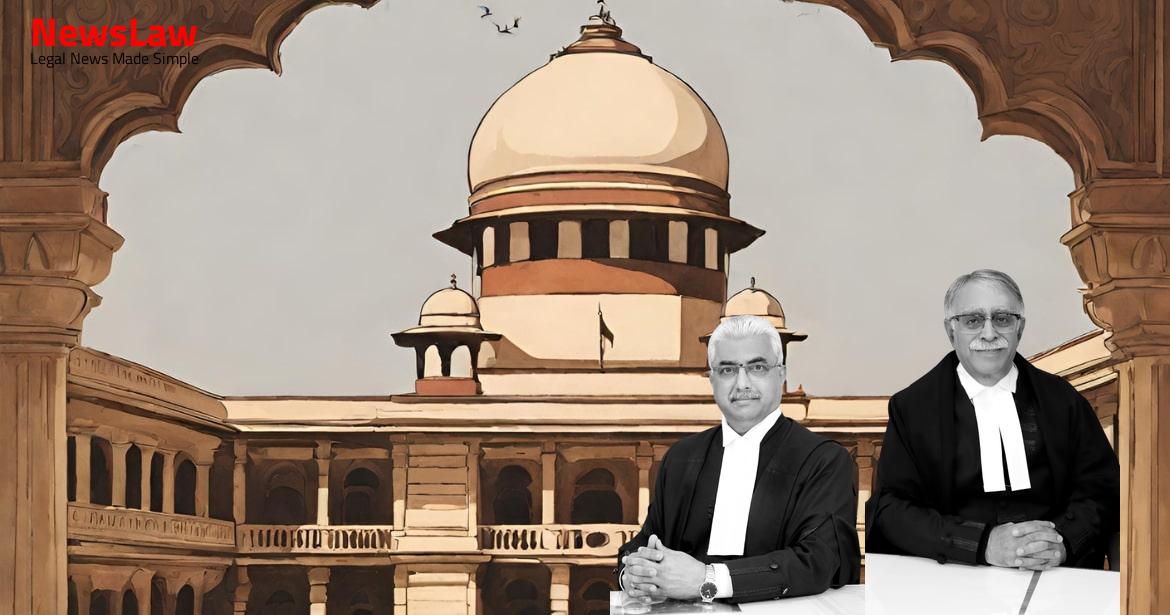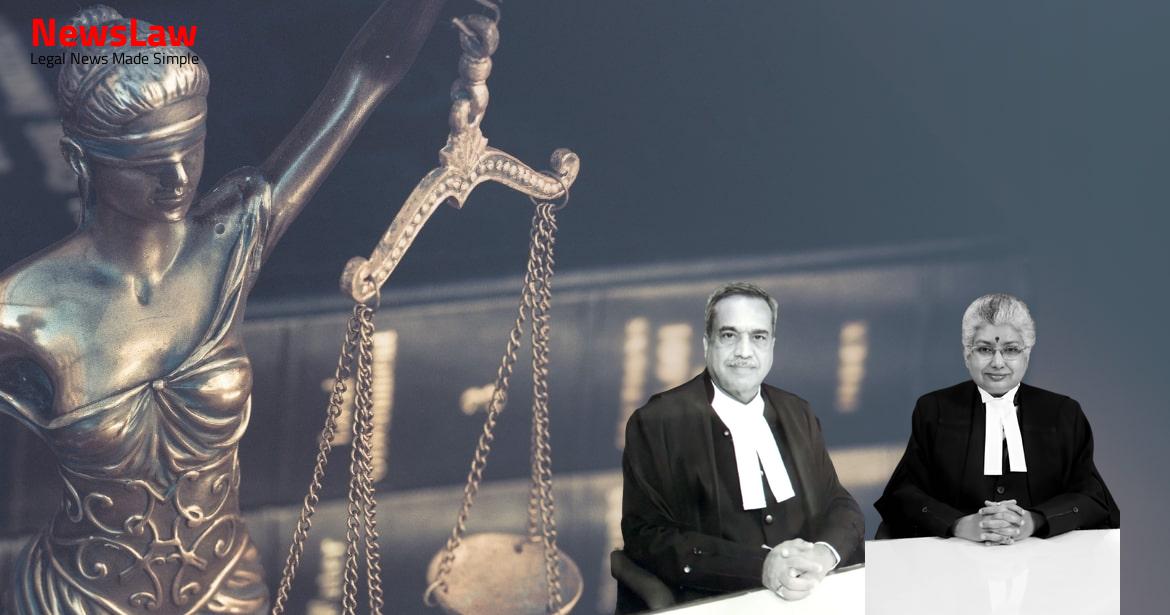Introduction
Explore the complexities of limitation laws and property rights in the context of adverse possession cases. The court’s detailed legal analysis sheds light on the importance of timely action and specific criteria to establish property rights. Follow this summary to unravel the intricacies of legal principles governing property disputes.
Facts
- Thayamma executed a further Settlement Deed dated 18 August 1952, bequeathing absolute interest in the properties to her sons Raghavulu Naidu and Munusamy Naidu, extinguishing the rights of Saroja and Gopalakrishnan.
- Munusamy had no children, and his wife Pavunammal enjoyed life interest in the property bequeathed to him.
- Plaintiff Gopalakrishnan filed a suit in 1993, claiming vested rights as the sole heir of Saroja.
- The trial court determined that the Second Settlement Deed could not have been executed without the existence of the first deed, and upheld the legal sanctity of the First Settlement Deed.
- During his lifetime, Munasamy executed a settlement deed in favor of Pavunammal, and two settlement deeds were executed in 1947 and 1952 involving different family members.
- The suit was deemed barred by Limitation and non-joinder of necessary parties, with questions raised about the legality of Vasantha’s adoption.
- The plaintiff’s claims were denied by the written statement, asserting that Pavanuammal was the sole heir to the properties and disputing any vested rights.
- Thayammal’s Third Settlement Deed in 1952 gave the suit properties exclusively to her two sons, leading to subsequent sales of portions of the properties by them.
- Munusamy’s wife is entitled to possession and enjoyment until her lifetime, without the right of transfer.
- The judgment and decree of the Trial Court was confirmed by the appellate court.
- The appeal that was filed was dismissed by the appellate court.
Also Read: https://newslaw.in/supreme-court/quashing-of-fir-on-grounds-of-civil-nature-legal-analysis/
Issue
- The issue of whether the plaintiff is entitled to a share in the suit property was examined by the courts.
- The plaintiff did not take steps to revoke transactions related to the suit properties.
- The third and fourth issues were decided against the plaintiff as they could not claim rights in the suit property.
- The High Court framed substantial questions of law regarding the Transfer of Property Act in relation to vested interest.
- The period of limitation for Gopalakrishnan to claim on the properties was discussed.
- The First Appellate Court considered the legal heirship of the plaintiff in relation to Saroja Ammal.
- The relief prayed for by the plaintiff and the entitlement to such relief were also in question.
- The Additional District Munsif framed issues related to the genuineness of the settlement deed and the plaintiff’s rights in the suit property.
Also Read: https://newslaw.in/supreme-court/conviction-modified-to-fine-case-summary/
Arguments
- The right of Saroja created as per the First Settlement Deed was a contingent interest as per the argument presented.
- Saroja’s interest was spes successionis, meaning it did not achieve concrete form and was only an expectation of succeeding.
- The contingency for Saroja’s interest depended on Munusamy either having or not having children.
- If Munusamy had a male heir, one half would belong to him and Saroja would get the other half after the life of Raghavulu and Munusamy.
- Upon Saroja’s death in 1951, her interest remained contingent on Munusamy’s situation.
- Reliance was placed on the case of Harmath Kaur v. Inder Bahadur Singh.
- The main contentions raised were regarding the nature of Saroja’s contingent interest and the lawfulness of the original plaintiff’s actions.
- Reliance is placed on Mahadeo Prasad Singh to assert that an expectation of succession prohibits transfers or contracts to transfer.
- The First Settlement Deed was executed and acted upon, showcasing a transfer of rights ‘in presenti’.
- Saroja holds a ‘vested’ right under the Transfer of Property Act, and this vested right remains even if the transferee dies before gaining possession, citing Sreenivasa Pai v. Saraswathi Ammal.
- The Second Settlement Deed granted Thayammal a life interest only for the two sons, making subsequent settlement deeds invalid in law and unnecessary to challenge.
- The non-seeking of relief within twelve years is justified by the fact that possession of the property was contingent on Pavunammal’s death in 2004, and since a suit is pending, the limitation for seeking possession is stayed.
Analysis
- The analysis section of the judgment delves into the issue of limitation in the suit for declaration based on the First Settlement Deed filed by Gopalakrishnan in 1993.
- The Trial Court and the First Appellate Court found that the suit was barred by limitation due to the failure of Gopalakrishnan to challenge certain settlement deeds within the prescribed timeframes.
- Contrary to the Appellant’s argument, it was highlighted that the relief of possession became available to Gopalakrishnan only after the death of Pavunammal in 2004 and was not claimed in the suit for declaration.
- Reference to the case law Saroop Singh v. Banto was made to stress that a claimant seeking declaratory relief, but not in possession, should have claimed the relief of recovery of possession within the limitations period.
- The analysis also considered the nature of the documents executed regarding the property and their impact on the limitation period for adverse possession.
- It was concluded that the suit for declaration filed in 1993 was barred by limitation as the twelve-year period had expired in 2016.
- The analysis emphasized the importance of seeking appropriate relief within the statutory limitations period to avoid the extinguishment of rights and highlighted the necessity for adverse possession claimants to meet specific criteria.
- The analysis further clarified that the lapse of limitation only bars the remedy but does not extinguish the title, reiterating the significance of adhering to limitation laws in property disputes.
- Limitation Act pertains to remedies as claims in respect of rights cannot be entertained if not commenced within the prescribed time.
- Any time fixed by the statute is necessarily arbitrary as there is no period of limitation under general law.
- A suit must seek consequential relief along with a declaration to be maintainable.
- Claims for declaration without seeking consequential relief are barred by law.
- Adverse possession involves competing rights between the possessor and the owner of the property.
- Law emphasizes on possession and intent in cases related to adverse possession.
- A suit seeking declaration of ownership without possession is not maintainable as per Section 34 of Specific Relief Act.
- Purpose of limitation statutes is to compel action within a reasonable time and discourage stale claims.
- Not being in possession of the property requires amendment of plaint to seek recovery of possession.
- Statutes of limitation involve extinguishment of rights or mere barring of claims without affecting the right.
- Part III of the Schedule to Limitation Act details time periods for seeking declarations.
- Laws give help to vigilant parties and not to those who delay.
- Limitation period does not confer a right of action or relief that has been barred by time.
- Right to sue accrues from the date the cause of action first arises.
- Suit for declaration must be filed within a reasonable time from the cause of action.
- Record shows no cause of action arose within the stipulated period for seeking declaration.
- Suit should have sought possession along with declaration at various possible occasions, but it failed to do so within the prescribed time.
- The appellant has been in possession of the subject property since 1976.
- The appellant is entitled to legal character or right as to the property.
- The appellant may institute a suit against any person denying his title to the property.
- The Court has discretion to make a declaration that the appellant is entitled to the property.
- The plaintiff need not ask for any further relief in such a suit.
- No declaration will be made if the plaintiff can seek further relief and omits to do so.
- Amendment of a plaint can be made at any stage of a suit, even at the second appellate stage.
- After the death of the life-estate holder in 2004, the original plaintiff did not attempt to amend the plaint to seek the relief of recovery of possession.
- The judgment fails scrutiny due to limitation and maintainability of the suit issues.
Decision
- The impugned judgment in Second Appeal No 1926 of 2004 dated 27th September 2012 titled as Gopalakrishnan & Anr. v. Vasantha & Ors. is set aside.
- Pending application(s) if any, shall stand disposed of.
- The appeal is allowed in the above terms.
- The judgment of the Trial Court in O.S. No 726 of 1993 as well as the First Appellate Court in S.C. Appeal Suit 47/99 FTC-II Appeal Suit 113/2002 which dismissed the suit of Gopalkrishnan on the grounds of limitation cannot be faulted with.
Case Title: VASANTHA (DEAD) THR. L.R. Vs. RAJALAKSHMI @ RAJAM (DEAD) THR. LRS. (2024 INSC 109)
Case Number: C.A. No.-003854-003854 / 2014



